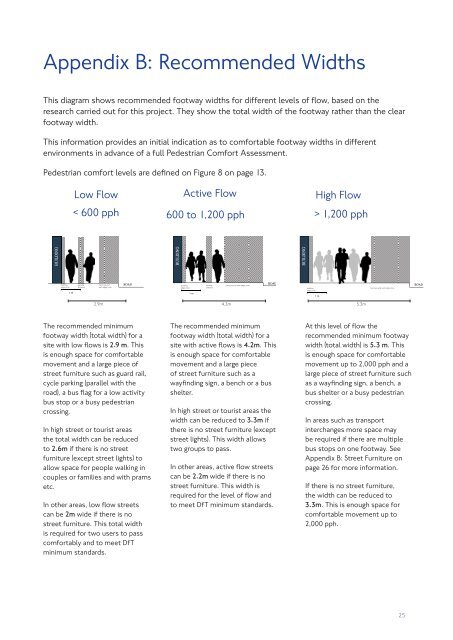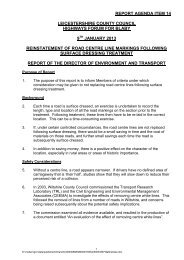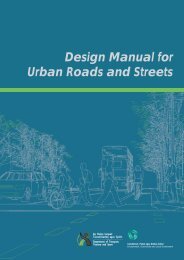Pedestrian Comfort Guidance for London
Pedestrian Comfort Guidance for London
Pedestrian Comfort Guidance for London
You also want an ePaper? Increase the reach of your titles
YUMPU automatically turns print PDFs into web optimized ePapers that Google loves.
Appendix B: Recommended Widths<br />
This diagram shows recommended footway widths <strong>for</strong> different levels of flow, based on the<br />
research carried out <strong>for</strong> this project. They show the total width of the footway rather than the clear<br />
footway width.<br />
building<br />
passing<br />
furniture and<br />
edge zone distance<br />
kerb edge zone<br />
This in<strong>for</strong>mation provides an initial indication as to com<strong>for</strong>table footway widths 1 m in different<br />
environments in advance of a full <strong>Pedestrian</strong> <strong>Com<strong>for</strong>t</strong> Assessment.<br />
<strong>Pedestrian</strong> com<strong>for</strong>t levels are defined on Figure 8 on page 13.<br />
BUILDING<br />
Low Flow<br />
Active Flow<br />
High Flow<br />
< 600 pph<br />
building<br />
passing<br />
furniture and ROAD<br />
edge zone distance<br />
kerb edge zone<br />
600 to 1 m 1,200 pph<br />
building<br />
passing<br />
edge zone<br />
distance > 1,200 pph<br />
The recommended minimum<br />
footway width (total width) <strong>for</strong> a<br />
site with low flows is 2.9 m. This<br />
is enough space <strong>for</strong> com<strong>for</strong>table<br />
building<br />
passing<br />
furniture and kerb edge zone<br />
edge zone<br />
distance<br />
movement and a large piece of<br />
1 m<br />
street furniture such as guard rail,<br />
cycle parking (parallel with the<br />
road), a bus flag <strong>for</strong> a low activity<br />
bus stop or a busy pedestrian<br />
crossing.<br />
BUILDING<br />
BUILDING<br />
building<br />
edge zone<br />
1 m<br />
passing<br />
distance<br />
furniture and<br />
kerb edge zone<br />
ROAD<br />
In high street or tourist areas<br />
building<br />
furniture and kerb edge zone<br />
edge zone the total width can be reduced<br />
1 m<br />
to 2.6m if there is no street<br />
furniture (except street lights) to<br />
allow space <strong>for</strong> people walking in<br />
couples or families and with prams<br />
etc.<br />
In other areas, low flow streets<br />
can be 2m wide if there is no<br />
street furniture. This total width<br />
is required <strong>for</strong> two users to pass<br />
com<strong>for</strong>tably and to meet DfT<br />
minimum standards.<br />
ROAD<br />
BUILDING<br />
BUILDING<br />
The recommended minimum<br />
footway width (total width) <strong>for</strong> a<br />
site with active flows is 4.2m. This<br />
is enough space <strong>for</strong> com<strong>for</strong>table<br />
building<br />
furniture and kerb edge zone<br />
edge zone movement and a large piece<br />
1 m<br />
of street furniture such as a<br />
wayfinding sign, a bench or a bus<br />
shelter.<br />
BUILDING<br />
building<br />
edge zone<br />
1 m<br />
passing<br />
distance<br />
furniture and kerb edge zone<br />
In high street or tourist areas the<br />
width can be reduced to 3.3m if<br />
there is no street furniture (except<br />
ROAD<br />
street lights). This width allows<br />
two groups to pass.<br />
ROAD<br />
In other areas, active flow streets<br />
can be 2.2m wide if there is no<br />
street furniture. This width is<br />
required <strong>for</strong> the level of flow and<br />
to meet DfT minimum standards.<br />
ROAD<br />
BUILDING<br />
BUILDING<br />
BUILDING<br />
building<br />
edge zone<br />
1 m<br />
1 m<br />
ROAD<br />
furniture and kerb edge zone<br />
2.9m 4.2m 5.3m<br />
furniture and kerb edge zone<br />
ROAD<br />
At this level of flow the<br />
recommended minimum footway<br />
width (total width) is 5.3 m. This<br />
is enough space <strong>for</strong> com<strong>for</strong>table<br />
movement up to 2,000 pph and a<br />
large piece of street furniture such<br />
as a wayfinding sign, a bench, a<br />
bus shelter or a busy pedestrian<br />
crossing.<br />
In areas such as transport<br />
interchanges more space may<br />
be required if there are multiple<br />
bus stops on one footway. See<br />
Appendix B: Street Furniture on<br />
page 26 <strong>for</strong> more in<strong>for</strong>mation.<br />
If there is no street furniture,<br />
the width can be reduced to<br />
3.3m. This is enough space <strong>for</strong><br />
com<strong>for</strong>table movement up to<br />
2,000 pph.<br />
25<br />
ROAD




